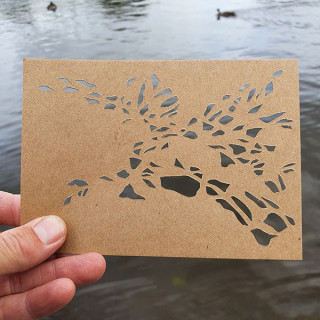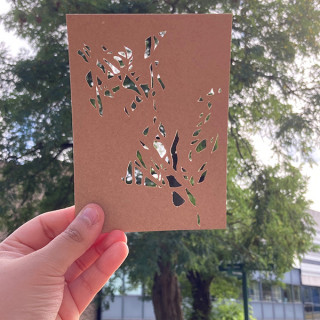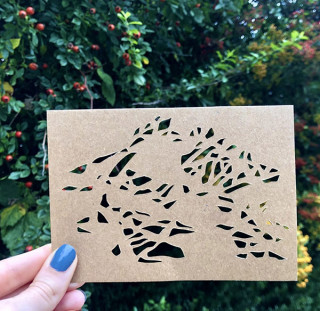© Pint of Science, 2025. All rights reserved.
Participatory Nature is a participatory artwork by artist Jessica Emsley, which responds to the research of Alexa Spence, particularly focusing on the salience of environmental issues through a shared identity and embodied experience, and taking reference from concepts such as Citizen Science.
Jessica invited volunteers from Pint of Science to take part in the initial stage, sending out postcards hand-cut using shapes from between blades of grass. The volunteers were then invited to hold the postcards up against a natural background in their own locality so that it shows through the spaces. A literal taking of responsibility for natural spaces into our own hands.
 |
 |
 |
 |
 |
You are invited to participate by downloading the template and cutting or drawing out the shapes before sharing your own images. You could cut the shapes out and hold the stencil against a natural background of your choice (always exercise appropriate safety measures when cutting out) or draw around the shapes and fill them with your own drawings, patterns or colours. It’s up to you!
Once complete, take a photo and upload to Instagram or Twitter with the hashtag #ParticipatoryNature and tag @stem_on_notts for a chance to win a Pint of Science t-shirt. Upload until the 30th September 2020 to be entered into the competition.
With thanks to participants: Ru Jia, Bruna Abreu, Alexa Spence, Tia Papoutselou, Franziska Wohlgemuth and Lizzie Killalea.
The people behind the collaboration
Are there specific materials, contexts in which you make your work?
Yes, I work with nature or what humans perceive to be nature. This means I typically start working outside although I may return to my studio space later, and that I work in a way that is responsive to specific locations. I often use organic materials or try to incorporate the organic into how I work by finding natural patterns, shapes and movements I can employ in my work.
Where do you find inspiration?
I find inspiration in my personal relationship with nature and in the relationship I see other people as having with nature. There are some artists whose work with the natural I really admire, such as John Newling and Natasha Myers. I think my broader interest in nature and environmentalism is rooted in the walking I do; I’m a keen walker and often go hiking and wild-camping in Scotland and Wales.
How did you start making art?
I’ve always loved drawing and I think this is at the core of my practice, even when I’m making work that extends beyond the act of drawing. I really enjoy the observation involved in drawing and how this can be extended beyond simply copying, to become a subjective observation and a translation into artwork. I suppose that, as my understanding of art increased, I saw the potential drawing had for holding or expressing greater meaning.
Can you think of a specific story or event over the years that boosted your creativity?
There are several, I think. I attended a summer school called the Expanded Field of Drawing which was an intensive three-week course at the Slade. This really confirmed for me that making art was what I wanted to do and helped me in my decision to pursue a Masters in Fine Art. I’ve also met several people over the last two years who were extremely interested in art and environmentalism and were themselves doing great things in the area. Speaking with them and having their support has really encouraged me to keep making and to be confident that there is value to exploring nature through creativity.
Did you ever encounter any obstacles regarding your work, and how did you manage to overcome them?
I often encounter obstacles and think the biggest help is the support of other people. Being on a Masters course, I have a whole network of creative people I can talk to when I encounter any issues or when I need to step away from something I’m working on. Within this process, having to rethink my work in response to Covid 19 and the new online platform was a big challenge but being able to ask Alexa’s opinion on ideas really helped me to work things out. I think we were really lucky to have had our initial meeting in person and to have been able to chat about her research.
Can you describe the collaboration with your scientist – did you meet, email, speak online? What did you talk about?
Alexa and I met before we went into lockdown. I went to visit her at her university office and we chatted about her research and my artwork. Whilst we shared interests within our work, we also found we had quite a bit in common elsewhere as we’re both outdoor lovers. I’m really into walking and running and Alexa sea-kayaks which sounds amazing. After our initial chat we were able to keep in touch by email and Alexa was a great help with developing the artwork as I was able to consult her on ideas and discuss her research further.
How did Covid-19 affect how you could work on this and other projects?
I did have to change my initial plans for Creative Reactions but tried to use this as a chance to adapt and acknowledge the new situation. Without this change I’m not sure I would have made something so participatory and definitely would not have made something to be experienced in the digital. The digital is something I’ve discovered in this current time; usually I’d avoid anything digital but I’m seeing its value a bit more and trying to find ways to merge my more organic way of working and digital, more accessible ways of sharing work.
Were you interested in science before participating in Creative Reactions?
I’ve always been interested in science and find it comes into a lot of my work as I’m often working with ecology and find a lot of research material within scientific writing. I had actually already been interested in exactly the research Alexa was doing as I studied a module for my undergraduate degree in which we looked into why people fail to act in response to climate change facts, despite the fact they believe this information.
How would you describe the benefits of collaborations between art and science?
I suspect there are a lot of overlaps between artists and scientists in that both are trying to reveal or describe something of the world. Art often seems to act as a means of communicating science and I think that science is itself creative. From an artist’s perspective, I find the collaboration between art and science allows for more informed and meaningful work which can be contextualised in something real and valuable.
Anything else that you would like to add?
Just a thanks to all the organisers. I’ve thoroughly enjoyed the process and think Creative Reactions is a wonderful initiative.
Alexa Spence – The Psychological Distance of Climate Change
What do you like the most about your research area?
I love that it’s relevant to current issues and that I can see the real everyday value in my research.
When did you decide to become a scientist?
I don’t think I ever actually decided, I just liked studying and never really left school.
Can you think of a story or event throughout your research career that inspired you?
I do always remember my previous boss – Professor Nick Pidgeon at Cardiff University – laughing at the idea that I was encouraging sustainable behaviour whilst driving a sporty BMW. He said that it may well help me to understand the people, and actions, that I was tackling. Indeed it did highlight some of the inconsistencies in my behaviour to me and many years later, whilst I still have a car, I now commute by bike. Altogether I think I spend a lot more of my time outdoors now – and love it.
Did you ever encounter any obstacles regarding your work, and how did you manage to overcome them?
I often encounter obstacles in the shape of reviewers comments on my work, and rejection emails. I think it’s so important to be able to take criticism on board, reflect on what you are doing, but above all persevere.
Can you describe the collaboration with your artist – did you meet, email, speak online? What did you talk about?
We met and emailed to discuss our interests. I now also follow Jessica on Instagram. We talked about our work and our interests. Jessica was actually already very environmentally aware, but it was great to talk further about theory that she wasn’t previously aware of, and how she interpreted the ideas that I presented to her. From my part, I was quite ignorant of her artistic approach and the process and I hope that my naive questions helped to cast light on possible directions for the project.
Was there anything that surprised you during your collaboration?
I’m surprised at how often images now remind me of my research and Jessica’s art. Jessica has some great pieces that build on natural shapes and patterns, and I now often notice these in the world around me, for example shadows from branches above on the pavement recently. I love that because one of the aims of my research is to find out how to make climate change and environmental issues salient to people – and Jessica has made environmental images more salient to me. It makes me think that abstract art (beyond well known climate associated images) can be an inspiring way to do this.
Were you interested in art before participating in Creative Reactions?
Yes, but I have very little knowledge of the art world. I love doing arts and crafts with my young son though!
How would you describe the benefits of collaborations between art and science?
I think it helps you get an outside perspective on your work, and to think about it in a more abstract way which I think also helps you see its value.
Further reading on Alexa's research and also in Nature Climate Change
Catch Jessica on Youtube Wednesday 9th September at 7.30 pm (recording available).
About this post
This blog post is part of the Creative Reactions Nottingham 2020 online exhibition. Over the month of September, we will be bringing you different examples of collaborations between art and science, including a chance to get creative yourself. More Creative Reactions blog posts.


